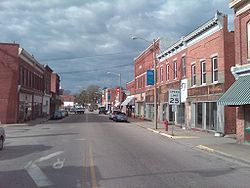
Park Place is a neighborhood in the western half of Norfolk, Virginia. Its boundaries are roughly Granby Street on the east, Colley Avenue on the west, 23rd Street on the south and up to 38th Street to the north. Within these boundaries Park Place is made up of 4 historic subdivisions; Virginia Place, East Kensington, Park Place, and East Old Dominion Place.
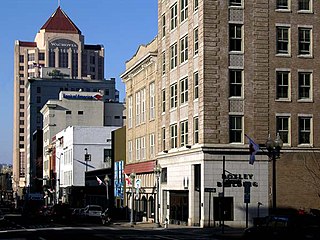
The Roanoke Downtown Historic District is a national historic district located in the Downtown Roanoke area of Roanoke, Virginia. It encompasses 122 contributing buildings. It includes a variety of commercial, institutional, social, and governmental buildings and structures from the late 19th century to the mid-20th century. Notable buildings include the Roanoke City Public Library, the YMCA Central Branch Building, First Christian Church (1925), the Central Church of the Brethren (1924), Tomnes Cawley Funeral Home (1928), Thomas B. Mason Building (1961), Peerless Candy Co., City Hall / Municipal Building (1915), Roanoke Times Building (1892), Anchor Building / Shenandoah Building (1910), Greene Memorial Methodist Church (1890), and United States Post Office and Courthouse (1930). Located in the district are the separately listed Patrick Henry Hotel, the Boxley Building, the Campbell Avenue Complex Historic District, Colonial National Bank, and First National Bank.

The Court House Hill–Downtown Historic District is a national historic district located in Lynchburg, Virginia. The area is situated on a promontory overlooking the Lower Basin Historic District on the south bank of the James River. The approximately 50-acre (200,000 m2) district is composed of relatively intact city blocks of religious, commercial, residential, and governmental buildings and structures ranging in date from the early 19th century to the mid-20th century. Buildings in the district represent a variety of styles from the different periods, including the Federal, Greek Revival, Gothic Revival, Italianate, Queen Anne, Neoclassical, Italian Renaissance, Spanish Eclectic, Craftsman, and Art Deco styles.

The Port Republic Road Historic District is a national historic district in Waynesboro, Virginia. In 2002, it included 83 buildings deemed to contribute to the historic character of the area, plus one other contributing structure and one contributing site, a foundation. They include buildings such as houses, garages, sheds, commercial buildings, churches, and meeting halls, and structures such as carports and animal sheds. The historically African-American neighborhood developed after the American Civil War. Notable buildings include the Shiloh Baptist Church (1924), the early-20th century Elks and Abraham lodges, the Rosenwald School, which incorporates a 1938-39 auditorium/gymnasium, and Tarry's Hotel (1940).

Town of Halifax Court House Historic District is a national historic district located at Halifax, Halifax County, Virginia. The district includes 172 contributing buildings, 1 contributing site, 13 contributing structures, and 1 contributing object in the Town of Halifax. Resources include government, commercial, residential, religious, educational and industrial buildings that date from the early-19th Century to the mid-20th century. Notable buildings include the Rice House, Edmunds/Lewis Office (1869), People's Bank, Beth Car Baptist Church (1892), Christ Episcopal Church, Saint Luke's Christian Methodist Episcopal Church, Dr. Carter House, County Office Building (1915), Town of Halifax Swimming Pool (1930s), Municipal Building/ Fire Station (1950), Halifax Roller Mills (1915), Halifax Planing Mill, Halifax Department Store (1949), and Randolph Theater. Also located in the district is the separately listed Halifax County Courthouse.

Luray Downtown Historic District is a national historic district located at Luray, Page County, Virginia. The district includes 75 contributing buildings, 1 contributing structure, and 3 contributing objects in the central business district of the town of Luray. They include residential, commercial, governmental, and institutional buildings in a variety of popular 19th and 20th century architectural styles. Notable buildings include the Skyline Building, Luray Motor Company (1935), Luray United Methodist Church (1899-1900), Luray Post Office (1938), Page County Record Building (1912), Bridge Theatre, Casey Jones Overall Factory (1922), Mansion Inn, Jordan-McKim Building, Hotel Laurance, and Mimslyn Inn (1930-1931). The contributing objects include the Confederate Monument (1918) and clock. Located in the district are the separately listed Luray Norfolk and Western Passenger Station and Page County Courthouse.

Saltville Historic District is a national historic district located at Saltville, Smyth County, Virginia. The district includes 104 contributing buildings and 3 contributing sites in the central business district and surrounding residential areas of Saltville. It includes a variety of residential and commercial buildings primarily dating from the late-19th to mid-20th centuries. Notable buildings and sites include Well Fields, Saltville Golf Course, Office Building (1850), Mathieson Alkali Office Building (1894), company store (1895), First National Bank of Saltville, St. Paul's Episcopal Church (1896), Gothic Revival style Madam Russell Memorial United Methodist Church, Duplex House (1894), Saltville Post Office (1931), Piggly-Wiggly Store, Saltville Savings Bank (1920), and Saltville Town Hall (1949).

Old Kentucky Turnpike Historic District is a national historic district located at Cedar Bluff, Tazewell County, Virginia. The district encompasses 35 contributing buildings, 3 contributing sites, and 3 contributing structures along Indian Creek Road and Indian Creek. They date from the late-19th to mid-20th centuries. Notable resources include the concrete bridge, steel railroad trestle, Cecil-Watkins House, Ratliff House, Cedar Bluff Presbyterian Church, the boyhood home of Governor George C. Peery (1873–1952), Thomas Cubine House, Gillespie House, the Old Cedar Bluff High School, Cedar Bluff High School (1906), and the Old Cedar Bluff Town Hall. Also located in the district is the separately listed Clinch Valley Roller Mills.
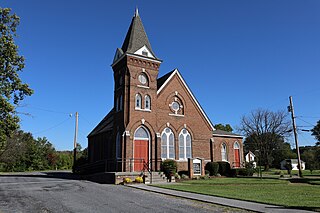
Riverton Historic District is a national historic district located at Front Royal, Warren County, Virginia. The district encompasses 66 contributing buildings and one contributing site in the town of Front Royal. It is a primarily residential district with buildings dating from the mid-19th century and including a diverse collection of building types and architectural styles. Notable buildings include Lackawanna (1869), the Old Duncan Hotel, the Riverton United Methodist Church (1883-1890), Dellbrook, the Carson Lime Company worker's houses, and the Old Riverton Post Office and Grocery. Located in the district and separately listed is Riverside.
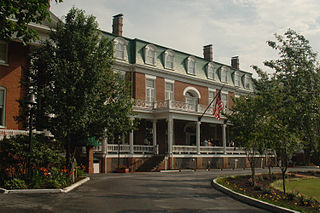
Abingdon Historic District is a national historic district located at Abingdon, Washington County, Virginia. The district encompasses 145 contributing buildings, 2 contributing site, and 13 contributing structures in the town of Abingdon. It includes a variety of residential, commercial, and institutional buildings dating from the late-18th century to the mid-20th century. Notable contributing resources include Sinking Spring Cemetery, William King High School (1913), General Francis Preston House (1832), Martha Washington Inn, Barter Theatre, the Virginia House, Alexander Findlay House (1827), Gabriel Stickley House, Ann Berry House, Washington County Courthouse (1868), Rev. Charles Cummings House, and James Fields House (1857). Located in the district and separately listed are the Abingdon Bank and Dr. William H. Pitts House.

The Downtown Danville Historic District is a national historic district located at Danville, Virginia. The district includes 48 contributing buildings in the central business district of Danville. It includes a wide range of commercial, industrial, and institutional building types dating from the 1870s to the present. The district includes notable examples of the Late Gothic Revival, Tudor Revival, and Romanesque Revival styles. Notable buildings include the Danville City Auditorium (1932), Morotock Manufacturing Company (1907), J. T. Stovall Tobacco Factory (1876), Kingoff Building (1892), American National Bank & Trust Co, Woolworth's Building (1937), Southern Amusement Building (1922), Elks Home (1912), Danville Post Office (1932), Masonic Building (1921-1922), and Danville City Market (1930s). Located in the district are the separately listed Hotel Danville and the Danville Municipal Building.

Belfield–Emporia Historic District, also known as North Emporia, is a national historic district located at Emporia, Virginia. The district includes 41 contributing buildings in the Belfield section of Emporia. In 1887, the neighboring towns of Hicksford and Belfield merged to form the town of Emporia. The district generally consists of late-19th- to early-20th-century brick buildings laid out in a "T"-shape at the intersection of Halifax and Baker Streets. Notable buildings include the Hotel Virginia, the Bethlehem Building or former First National Bank of Emporia (1907), Petersburg and Danville Railroad passenger station, and Pair's Furniture. Located in the district is the separately listed H. T. Klugel Architectural Sheet Metal Work Building.

Hampton Downtown Historic District is a national historic district located at Hampton, Virginia. The district encompasses 25 contributing buildings and 7 contributing sites in the central business district of Hampton. The district includes a variety of commercial, residential, institutional, and governmental buildings dating from the late-19th to mid-20th century. There are notable examples of the Beaux-Arts, Art Deco, and Gothic Revival styles. Notable buildings include First United Methodist Church, the Sclater Building (1871), St. Tammany's Masonic Lodge (1888), Hampton Baptist Church (1883), Old Hampton Station Post Office (1914), and the circuit courthouse (1876). Located in the district and separately listed are St. John's Episcopal Church (1728) and the former Hampton City Hall (1939).
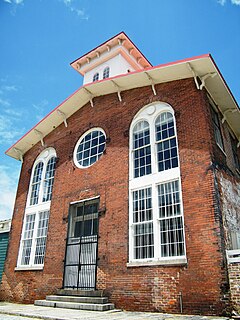
Petersburg Old Town Historic District is a national historic district located at Petersburg, Virginia. The district includes 174 contributing buildings located in the oldest section of Petersburg. It includes a varied collection of late 18th- through 20th-century architecture. Notable buildings include the Strachan-Harrison house, the John F. May house, South Side Railroad Depot, High Street United Methodist Church, Church of Christ (1925), and the Powell Manufacturing Co. Located in the district and separately listed are the Appomattox Iron Works, City Market, Exchange Building, Farmers' Bank and Nathaniel Friend House.
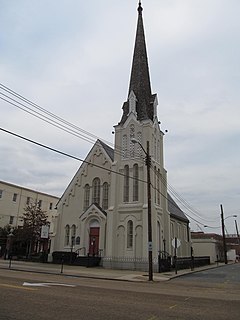
Downtown Portsmouth Historic District, also known as the High Street Corridor Historic District, is a national historic district located at Portsmouth, Virginia. It encompasses 229 contributing buildings, 1 contributing site, 4 contributing structures, and 1 contributing object in the central business district of Portsmouth. The district encompasses the original 1752 plan of the Town of Portsmouth and includes portions of expansions of the original boundaries dating to 1763 and 1909. It includes a variety of commercial, government, and institutional buildings, with most dating to the years around the turn of the 20th century. Notable buildings include the Captain Baird House, Vermillion Manor (1840), City Hall Building (1878), former United States Post Office (1907-1908), First Presbyterian Church (1877), First United Methodist Churches (1882), St. James Episcopal Church, Ebenezer Baptist Church, YMCA building, Tidewater Building, Southern Aid Building, Colony Theater, Lyric Theater, Blumberg's Department Store, Mutual Drug Company (1946), the New Kirn Building, and the Professional Building. Separately listed are the Commodore Theatre, Portsmouth Courthouse, Pythian Castle, St. Paul's Catholic Church, and Trinity Episcopal Church
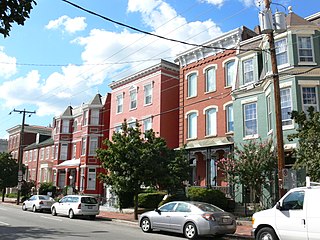
The Block 0-100 East Franklin Street Historic District is a national historic district located at Richmond, Virginia. It is located west of downtown. The district encompasses 21 contributing buildings built between about 1840 and 1920. The district is characterized by numerous mid- to late-19th century brick town houses in a variety of popular 19th-century architectural styles including Queen Anne, Italianate, and Greek Revival.

The Carver Residential Historic District is a national historic district located at Carver, Richmond, Virginia. The district encompasses 312 contributing buildings and 1 contributing site located west of downtown Richmond. The primarily residential area developed starting in the mid-19th century. The buildings are in a variety of popular 19th-century and early 20th-century architectural styles, including Gothic Revival and Greek Revival. Notable buildings include the Hardin Davis House (1842), Amanda Ragland House (1843), Reuben Lacy House (1859), Rueben T. Hill House (1900), George Washington Carver Elementary School (1887), Moore Street Baptist Church (1909), Baughman Brothers/Biggs Antique Company building (1924), and the T&E Laundry Company Building.

The Fifth and Main Downtown Historic District is a national historic district located in downtown Richmond, Virginia. The district encompasses 38 contributing buildings and 1 contributing object located south of the Grace Street Commercial Historic District. It reflects the core of the city's early-20th century retail development. The district includes representative examples of the Federal, Greek Revival, Classical Revival and International Style architecture built between the mid-19th and mid-20th centuries. Notable buildings include the Equitable Life Insurance Building (1951), the Massey Building, and 400 East Main Street (1951). Located in the district is the separately listed St. Alban's Hall (1869).
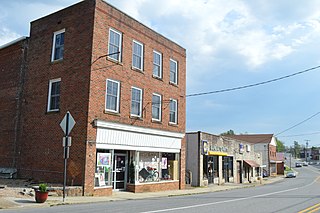
Gretna Commercial Historic District is a national historic district located at Gretna, Pittsylvania County, Virginia. The district encompasses 26 contributing buildings in the central business district of Gretna. The district primarily developed in the early-to-mid-20th century, with buildings dated between about 1881 and 1963. Notable buildings include the Thomas C. and Robert H. Creasy storehouse (1881), Masonic hall (1902), Bank of Elba (1907), Dalton building, W.D. Love and Co. grocery store, Amoco Service Station (1940), former Gretna Fire Station and Town Hall, and Berger Motor Co. (mid-1940s).
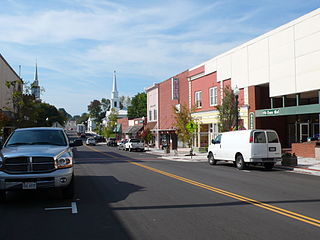
Christiansburg Downtown Historic District is a national historic district located at Christiansburg, Montgomery County, Virginia. The district encompasses 32 contributing buildings, 1 contributing site, and 2 contributing objects in the central business district of Christiansburg. The district includes a variety of one-, two-, or three-story commercial or office buildings built primarily from the 1915-1950 period. The courthouse square is the cultural and historic center of the district. Notable buildings include the Taylor Office Building, Bank of Christiansburg (1963), Dr. George Anderson House, Zirkle Building (1910), Cromer Furniture Building, Presbyterian Manse (1876), Barnes-Surface Motor Co., Virginia Inn Hotel, and Leggett's Department Store (1958). The contributing objects are the Confederate Memorial (1883) and War Memorial (1953). Located in the district and separately listed are Christiansburg Presbyterian Church, U.S. Post Office, and Phlegar Building.
